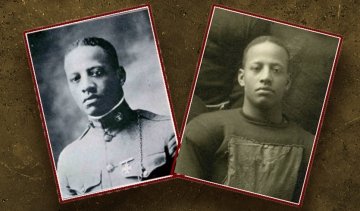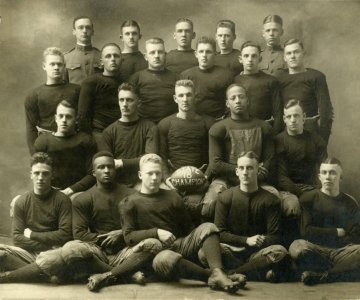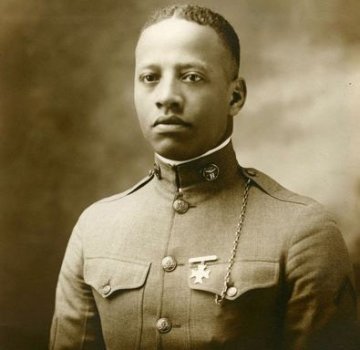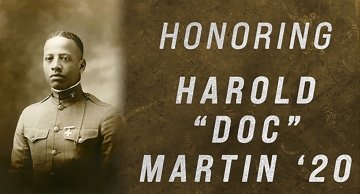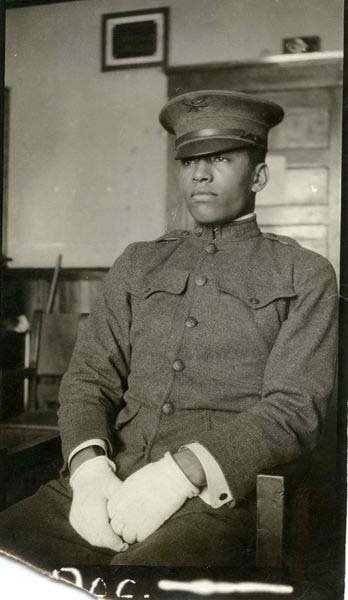Harold "Doc" Martin was a true Norwich Renaissance Man
Norwich University is replete with distinguished alumni, Cadets of valor who have achieved significant accomplishments, and Harold 'Doc' Martin stands squarely with all of them.

On February 9, the Harold "Doc" Martin '20 Memorial Scholarship benefit dinner was held in Washington D.C. at the National Press Club. The scholarship was established in 2021 to honor the legacy of Norwich University's first Black graduate and Tuskegee Airman. In preparation for the event, Athletic Director Ed Hockenbury worked with members of the athletic department to chronicle Doc's achievements. It quickly became apparent that Doc's accomplishments were too numerous and too significant to be covered at one time.
Norwich Athletics recently concluded a special series of articles on 'Doc' Martin celebrating the many accomplishments including his time at Norwich, Cadet football career, professional career prior to World War II, his service during World War II as a part of the Tuskegee Airmen, and finally his lasting impact as Norwich University's first Black graduate.
A True Norwich Renaissance Man
Doc Martin was a true renaissance man throughout his entire life, but especially while at Norwich. A groundbreaking Cadet that shined in almost every endeavor he undertook, his many accomplishments almost seem impossible for one man to single-handedly do. The Norwich University Athletic Hall of Fame member was a star football player, captain of the hockey team, played baseball, ran track, was a member of the student council, sang in the Glee Club, played in the Mandolin Club, was the athletic editor of the War Whoop, and all while studying electrical engineering.
His entire life was a list of pioneering endeavors. It almost seemed as though he was predestined to routinely break down barriers. After graduating from Boston Latin School, he became the first Black Cadet in Norwich history but it would only be the beginning of a long line of firsts for Doc. He is also the first Black athlete to play for the Cadets and, by all accounts, is the first Black athlete to ever play college hockey in the United States. Doc is the oldest member of the Norwich Hall of Fame and one of two members of the class of 1920 to be represented so far.
Miner Teachers College, now known as the University of the District of Columbia, published a eulogy entitled "Tribute to Our Coach" in the Varsity on April 25, 1945, which aptly encompasses the wide ranging and lasting impact he had on those around him. It begins, "Sincere and eulogistic statements offered in the past few weeks attest to the valued work of Major Harold Douglas Martin, late instructor at the college. The college community, athletics, public school physical education, camp life, church work, the war program – it is incredible that a man could make an honest contribution in so many fields of work."
A Man of Many Firsts
As a student at Norwich University, Harold "Doc" Martin made a habit of being a barrier breaker. His entire time on the Hill was nothing short of groundbreaking. Often times, phrases such as groundbreaking are flippantly used for common activities, but in this situation, it actually undersells what all he did. In short, Doc is one shining example of fulfilling the school motto "I Will Try."
A very forward-thinking alumni wrote a letter of recommendation for Harold Martin as Martin prepared to finish his studies at Boston Latin School. The alumni saw the untapped potential within a young Doc Martin and understood how beneficial Doc's time could be in Northfield, both for Doc and for Norwich as a whole. In 1916 he was matriculated as the first black student in university history. "When the story of the black athlete in America is written from an historic perspective, it will include the name of Norwich University's Harold 'Doc' Martin, one of the first black college athletes." (Norwich University Record)
Doc's athletic exploits were as extensive and diverse as any athlete to ever wear the maroon and gold. On the field of play is what Martin is most often known for and was a multisport athlete who competed in four sports. He was a standout on the gridiron, being named team captain in 1918 as a half-back, known for his elusiveness. "'Doc' Martin was back and carried the bulk of the work. Along with him were a few old men who had had varsity experience during their freshman year which helped considerably." (War Whoop, 1920) There are numerous articles in The Record and The Reveille during his time at Norwich which are filled with stories of athletic accomplishments. Along with being a leader on the football field, Martin also was a member of the hockey, baseball, and track teams. His leadership also showed up in hockey as he was named captain. In fact, he is widely viewed as the first black college hockey player in the United States. For baseball, he was a five-tool player along with being one of the aces of the pitching staff. After graduation he would continue his baseball career playing professionally for a few years. In recognition for his play on the many athletic fields, Martin was inducted into the Norwich University Hall of Fame in 1984 as part of the second hall of fame class ever. He is one of the two members of the class of 1920 to be honored.
Beyond the athletic fields, Doc Martin was a man of wide-ranging skills and interests. He clearly had a thirst for gathering as many experiences at this great institution as he could. "Doc is an all-around man." (War Whoop, 1920) Doc certainly filled his time while on campus. Besides playing on four different athletic teams he also was the leader of the mandolin club, member of student council, sang in the glee club, and was the athletic editor of the War Whoop while being an electrical engineering major. The oldest college band in America, Norwich University's own, also benefited from Doc's abilities and interests. "It takes 'Doc' to get the pep out of the band. The instruments fairly talk when he handles the baton." (War Whoop, 1920)
"During the sophomore year 'Doc' found favor at court and from that time on his military success has been assured. Gaze on him now as he steams forth in the regalia of a Top Sergeant and reports his Troop as present." (War Whoop, 1920) As a member of the Corps he rose to the rank of 1st Sergeant and was part of the artillery squad. "However, here's wishing him success in life, and we know that he will succeed as he possesses that essential quality – 'pep.'" (War Whoop 1920)
One of the Best Football Players to Ever Wear the Maroon and Gold
The combined descriptions of Doc Martin are those of an all-around athlete, but more importantly, a tremendous teammate. It was said often that he did not seek attention for himself and repeatedly brought up how he adjusted what he did for the betterment of the team. Could a better acknowledgment of greatness be made? While playing in an era where statistics can be difficult to locate, the best way to explain an athlete's stardom is through the words of his teammates, peers, and opponents.
The War Whoop description of Doc Martin stated "here we have the center about which many of our football victories are woven. The Hula dance exhibit which he gives when carrying the ball is worth going miles to see. After each game the highest medical skill is called in to attend to his opponents. Well, so much for his athletic prowess." In today's language, Doc was routinely breaking ankles while putting on a show on the field. In another year's War Whoop it explained his talent by saying "Doc is an all-around man. Many a football victory has been due to his slipperiness – now you see him and now you don't; that's him on the gridiron."
During his playing career he was the consummate all-around athlete. An excellent runner, an adept passer, physical player on defense, an extremely intelligent player, and even became the team's kicker out of necessity. "But, it had in Martin a back with two years' experience, whose field of running was off tackle, where his elusive dashes won him rightly the reputation of being the star of the team," said a Reveille article. "He made no long sprints for touchdowns in any games but aided by the splendid team-work of his line and backs and his own skillful playing, he scored or brought the ball in scoring distance in most of the games. A bit of luck would have sent him through Boston College for a touchdown, for he broke through almost the entire team. Lacking a brilliant kicker, the team called upon Martin, and he did effective work after the Dartmouth game, improving steadily during the rest of the season. After he caught the idea of throwing a certain type of pass, he threw it cleverly and on the field of play his headwork counted for touchdowns made by other players. A large portion of the success of the team is due beyond question to Martin." Two particular plays from Martin's career are worth specifically noting. In the season review, The War Whoop wrote "the most spectacular play of the game came in the very last minute of play. 'Doc' Martin heaved a long pass to 'Babe' Hyland, the best end ever at Norwich, and the little wizard scooped it in and tore for the goal and Norwich's second touchdown. Martin kicked a goal! This was Norwich's first victory in Boston (against Boston University), and was a great ending for a great season."
The opening paragraph in a game recap from The Record described another pivotal play by writing "standing nearly fifty yards from the opponent's goal, 'Doc' Martin, the Norwich half back, held the ball as coolly as if no men were charging toward him. And then, with a long, true pass, he settled the ball into Hyland's hands, twenty five yards down the field." Later in the article it explained the importance of the play. "Such was the sensational finish of the 1918 Vermont State Championship series; in such a way did N.U. make good her claim as state champion."
Towards the end of Doc's playing days at Norwich there were several common threads in articles. He was often described as a great teammate, a truly physically tough player, committed to Norwich, and there was an overall thankfulness of those who were grateful to have the opportunity to have covered his games. A Reveille article late in Doc's playing career put it best. The article said "about all that can be said of Martin is to say he was 'there' with a vengeance. His playing has been a delight to the present writer ever since he saw him on the field for the first time."
As Doc Martin finished his playing career, his accomplishments were well noted. In fact, The Record reprinted Doc's unofficial nomination to be an All-American. The Record stated "in the sporting column of the New York Times of November 24, 1919, appears a request from Northfield, that H.D. Martin, half-back and Milton J. Herrick, guard, be considered when the names of the star performers on the gridiron this season, come up for Walter Camp's mythical All-American football team. Neither man needs an introduction to football followers of this state: and around Boston, Martin has been known as a stellar performer from his high school days, and is one of the shiftiest and greatest open-field runners that has ever worn the maroon and gold." Although he did not make that year's coveted All-American team, his football career was certainly worthy of such recognition.
One of the last articles written in The Record about Doc Martin's Norwich football career best sums up who Doc was on the football field. It is arguably the greatest compliment which could be paid to an athlete. The article said "H.D. Martin ("Doc") plays his last game for Norwich this year. He leaves a reputation that will stay long behind him as one of the best N.U.'s backs. The Dartmouth official writeup after the Dartmouth game said he was 'one of the finest defensive backs ever seen at Hanover.' Seeking no personal glory for himself, he has played the game with his team. Last year, the offense was built largely around him, and his shifty, elusive, heady dashes off tackle were the plays that carried the ball to striking distance of the goal lines of the five teams beaten last year. This year, in an offense of a different type, his power has shown up as an interferer and in defensive play. He has been loyal to N.U., to his team, to his coach. This is the tribute of one who has worked with him in football when the going was rocky, and one who knows him. A football player from the ground up whose football is over – 'Doc', so long and good luck."
A Leader in Every Meaning
It is easy to look at what Harold "Doc" Martin accomplished in college and feel as if there is no feasible way those achievements could be topped, but Martin's post-Norwich University career stands up to the challenge. The multi-sport star turned his talents into several administrative roles, from a teacher, a coach, and an athletic director.
After his graduation from Norwich, Martin first found employment as a teacher at universities in Richmond, Va., and Raleigh, N.C. from 1921 to 1927. While furthering his academic status, Martin also became an extremely successful multi-sport coach, with stops at Virginia Union, Shaw University, and Virginia State College within their respective football, basketball, baseball, and tennis programs. He also saw a year of action in professional baseball, spending time with the Pittsburgh Keystones.
From a Tuskegee, Alabama newspaper, "During these thirteen years, this health education specialist had received his master's degree from New York University. He had played professional football and declined an appointment as a West Point cadet. In 1934, he transferred his activities to college where he remained until 1942. The ex-professor, a member of Washington's Bachelor Benedict Club, spent his vacation as director of summer camps. He was a first lieutenant in the first colored auxiliary police in Washington."
Martin's coaching tenure at Virginia State began without a hitch, as "the beginning of a great athletic program for the college was presaged when Coach Martin's boys kicked hapless Bowie, 52-10, on the first Founder's Day, 1933" (Varsity). His stature as a coach was without question, even in other sports, which was highlighted "in the March issue appeared a picture of the first Miner basketball team coached by Martin, who sported his characteristic mustache and, according to another note "decreed" no competitive mustaches to be work by varsity men."
His triumphs were not just on the field, where "his football teams were fighting teams winning and losing good games," but also on the hardwood. During his second complete year at Miner, Coach Martin "had trained a good team and inspired it to play great basketball", taking his team in front of around 1,500 spectators where they "whipped Howard University, then CIAA championships," 45-36. "Coach had taken a group of fellows, only one of whom had played ball in high school, and had brought them to a level of knocking off top college teams."
For his illustrious career, Martin finished his football coaching career with a wildly impressive 63-22-12 record, including a 42-9-4 mark solely at Virginia State. The 1929 campaign saw the Trojans finish a perfect 9-0. In total, Martin claimed nine CIAA championships between 1921 and 1931, with four coming in football, a pair in baseball and tennis, and one in basketball.
But Martin's accomplishments stretched beyond coaching positions, and into administrative and leadership titles. He served Miner at the Twelfth Annual Spring Conference of the Eastern States Association of Professional Schools for Teachers in 1936. In the May 1937 issue of Varsity, "a condensation of a research paper on development of physical education programs and an editorial on 'The Student Health Problem' both appeared — work of Harold D. Martin, instructor in physical education."
His lengthy list of extracurricular activities during his time at Norwich, likewise, found its way into his post-collegiate life. Martin was appointed the chairman for the First Annual College Carnival by the College Life Committee in May 1938, a position he honored until he entered the military come World War II. His tutelage style sprung to life in this position, as, in November, it was "reported that Coach Martin 'has sent out requests for the names of any men interested in the singing of Christmas carols on Christmas eve.' He trained the men to sing. The next month Coach Martin explained to the assembled students the value of the Tuberculosis X-Ray examination."
Coach Martin's experiences with track in college also aided him with his community service, as he organized an annual city-wide track meet for elementary schools and junior high schools. "This excellent educational contribution proved an opportunity for youngsters to enjoy clean competitions and an opportunity for the men of college to organize and train the entries."
But even with his busy lifestyle, Martin still dedicated his most valuable time to the former Miss Beatrice C. Boyd, his wife of 15 years. She worked together with Martin, exhibiting "the same delight in physical education work." She did professional dancing and assisted the physical education director while taking special courses at Tuskegee Institute.
And even as war began, Martin did not suffer a misstep in his athletic conquests. In 1940 at the Fayetteville tournament, Martin's team won the first annual basketball trophy of the Eastern Intercollegiate Athletic Association. His 1941 football team won several games by significant margins, and the next year, he served the school faithfully "at the automobile accident involving most of the basketball team and saw that all men were hospitalized for necessary treatment, many of whom are now in the armed forces of the U.S.A" (Varsity).
And this all barely scratches the surface of what Martin accomplished in the years between Norwich University and World War II. Martin was a former CIAA commissioner of football officials, a physical education director, a successful multi-sport coach, a well-rounded teacher, and a man who dedicated his life to his community.
No greater sentence can summarize Martin's life than what was written in a tribute piece in Varsity after his passing: "Sincere and eulogistic statements offered in the past few weeks attest to the valued work of Major Harold Douglas Martin, late instructor in the college. The college community, athletics, public school physical education, camp life, church work, the war program – it is incredible that a man could make an honest contribution in so many fields of work."
World War II and The Tuskegee Airmen
Doc Martin's lifetime of exceptionalism continued during World War II. While being an instructor at Miner Teachers College, he, like so many other Americans, willingly answered the call to defend their country. Doc requested a leave of absence from his position with the school to enlist and help the war effort. Much like the rest of his life, he was again associated with groundbreaking greatness and this time it would take him to the Tuskegee Army Air Field.
Few military units have garnered as much notoriety for their successful heroic actions as the Tuskegee Airmen. But, that was not a forgone conclusion when Doc Martin joined the military. The Tuskegee Experiment, as it was known in its early years, built one of the most successful air units in military history. Doc first arrived at Tuskegee Army Air Field in May of 1942. He would be promoted to Director of the Ground School in March of 1943 and continue in that role until his untimely death in a military flight in March of 1945.
Several books and movies have been focused on the achievements of the Tuskegee Airmen and routinely focus almost exclusively on the pilots. Several of those pilots have spoken out about the backbone of their unit being the ground crews and instructors. The intense and advanced instruction given at Tuskegee was often credited with the overall success. The ground school courses normally covered engineering, maintenance, armament, gunnery, advanced navigation, and both tactics and techniques of aerial warfare. These lessons helped the Tuskegee Airmen to fly over 1,500 missions, over 15,000 sorties, while destroying over 260 enemy aircraft. They also won more than 850 medals.
Military.com described the unit saying, "the Tuskegee program also forged a group of men who would earn advanced degrees and make notable achievements in the fields of law, social policy, politics, medicine, education, and finance." One of the most remarkable aspects is that civilian aviation was not a viable career path, due to segregation, at that point and time for the thousands of men and women who were part of the Tuskegee program. It truly was a collection of some of the best and brightest, much like Doc Martin, who united to help build the successful unit.
This unit was so impactful that its members were collectively bestowed a specific and unique medal. The Smithsonian written description of the medal states "the Congressional Gold Medal is the highest civilian recognition awarded by the U.S. Congress. This medal was presented to the Tuskegee Airmen, African American pilots flying for the U.S. Army Air Force during World War II. Awarded on March 29, 2007, the medal recognized their 'unique military record that inspired revolutionary reform in the Armed Forces.'" The medal itself is "a gold medal featuring three men in profile in the center, with 'Tuskegee Airmen' at top and an eagle with spread wings at the bottom."
The impact of Doc Martin and the rest of the Tuskegee Airmen was not simply limited to the battlefield. "Yet in that moment, a group of determined individuals boldly charted a course that would forever change our nation and our Air Force," said Air Force Maj. Gen. Darren McDew. "We look with pride to the extraordinary impact you have made on our nation; your legendary skills in combat; your strength of character in the face of bias and ignorance; and your remarkable contribution to the integration of the armed services." The National Museum of the United States Air Force describes the lasting impact with the following. "When the U.S. Air Force became a separate service in 1947, it benefited directly from the experience of the Tuskegee Airmen. The USAF was the first service to erase the color line, thanks largely to the pioneering efforts and courageous legacy of the Tuskegee Airmen."
In March of 1945, Maj. Doc Martin was killed when the military flight he was on crashed in North Carolina. He was subsequently buried at Arlington National Cemetery with full military honors. His life, while only 46 years long, was one of unbelievable triumph and accomplishment. While at Norwich University he was a shining example of what it meant to be a Cadet and was enthusiastically engaged in a wide range of activities. After graduation he continued to use his experiences from Norwich to enrich thousands of lives as a college coach, college administrator, and eventually a college instructor. Then, he joined the long line of Norwich graduates who not only served their country but brought distinction to the military through their service.
His Lasting Legacy
Despite his sudden passing in 1945, Martin's memory has stood the test of time, courtesy of those who have accepted the weight of carrying his legacy.
Martin was at the forefront of Norwich's thoughts when the athletic department opened its Athletic Hall of Fame in 1983, earning induction a year later in 1984 and becoming the first Black athlete inducted at Norwich University.
Virginia Union University, where Martin was the head football coach and athletic director from 1922 to 1924 and led VUU to its first National Championship in 1923, followed suit decades later, honoring Martin with an induction in 2013, 90 years after the national title.
Martin's fingerprints are still all over Norwich, especially to this day. He is the namesake of the Harold "Doc" Martin Society, a multicultural student group that promotes a community of acceptance, inclusiveness, and diversity on campus.
Most recently, Norwich University established the Harold "Doc" Martin '20 Memorial Scholarship in 2021, which is awarded to "talented minority students with financial need attending Norwich" and honors Norwich's "first black graduate and Tuskegee Airman" (Norwich University).
The significance of the scholarship and its impact was magnified just this month, as on Thursday, Feb. 9, 150 alumni, parents, students, and friends gathered at the National Press Club in Washington, D.C. for the first annual Harold "Doc" Martin Norwich University Class of 1920 scholarship benefit dinner.
The event raised $200,000 for the scholarship and featured live and silent auctions and a video message from Brig. Gen. Woody Woodhouse, who served as a Tuskegee Airman with Martin. Maj. Gen. Cedric Wins, superintendent of VMI, was the guest speaker.
The event was a success thanks to the efforts of the scholarship committee: Maj. Gen. Cedric D. George, USAF (RET) '87, Anthony Johnson '94, Lowell Price '93, and Tonya Thorne '94. Willie Wright '93 is the committee chair and emceed the benefit dinner.
Martin's reach is nothing short of breathtaking – from his time as a teacher and administrator, where he tried to break barriers in the collegiate world, "he often said that life in a college would never become what it should be until faculty and students learn to bridge the gap that had been built up between them. This was a part of his philosophy. He participated freely and fully in all phases of the college life. He loved to sing and enjoyed training the men in a glee club and playing his violin at student affairs" (Varsity).
The abrupt death of Martin was nothing short of a shock to his community, but the remembrance of his time and efforts has also been nothing short of inspirational and extraordinary.
From the Varsity tribute: "And so when the news of his death came, we knew that Miner (Teachers College) had suffered a calamity – we knew that his loss was irreparable. Major Martin was a great coach, an inspiring teacher, and a grand person. It is hard to understand why he should be taken at this time, when he was so sorely needed and when he had so much to give. We must believe that somehow, somewhere in the Great Scheme of Things the spirit of Harold Martin lives on!"
* * *
Norwich University Athletics sponsors 24 varsity athletic programs and competes at the NCAA Division III level. Our primary conference affiliation is the Great Northeast Athletic Conference (GNAC). Since joining the GNAC in 1998, Norwich has won 76 conference championships. Norwich has won a total of 12 national championships with six NCAA Division III National Championships (four – men’s hockey, two – women’s hockey), and six more in women’s rugby. We have also had 20 CoSIDA Academic All-Americans, including 16 since 2012. www.norwichathletics.com
Norwich University is a diversified academic institution that educates traditional-age students and adults in a Corps of Cadets and as civilians. Norwich offers a broad selection of traditional and distance-learning programs culminating in baccalaureate and graduate degrees. Norwich University was founded in 1819 by Captain Alden Partridge of the U.S. Army and is the oldest private military college in the United States of America. Norwich is one of our nation's six senior military colleges and the birthplace of the Reserve Officers’ Training Corps (ROTC). www.norwich.edu
Media contacts:
Saraa Kami
Director of Communications
SKami@norwich.edu
Marc Kolb
Director of Athletic Communications
mkolb@norwich.edu
Marcus Popiolek
VP Marketing and Communications +
AVP Enrollment Services, College of Graduate and Continuing Studies
mpopiole@norwich.edu
Follow us on Twitter @norwichnews
Harold Doc Martin
Harold "Doc" Martin
Read More

Finding Purpose
Led by their Guiding Values, the historic Norwich University Corps of Cadets has produced a noteworthy community of leaders - today's cadets want to be a part of it.

Norwich University Cadets Complete Annual 50-Mile Legacy March, Raising Funds for Local Veterans
Thirty-five Norwich University cadets completed the annual Legacy March from November 1–3, 2024, retracing the symbolic 50-mile route from Norwich, Vermont—the birthplace of the university—to its...
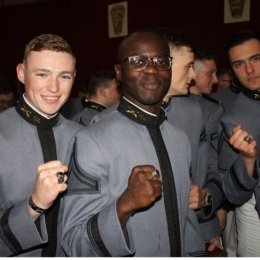
MCV Class '26 Earns Their Norwich Rings in Time-Honored Ceremony
Planned and executed by the MCV Class Ring Committee, the event honored the cadets' perseverance and commitment to the Norwich values of leadership and service.


